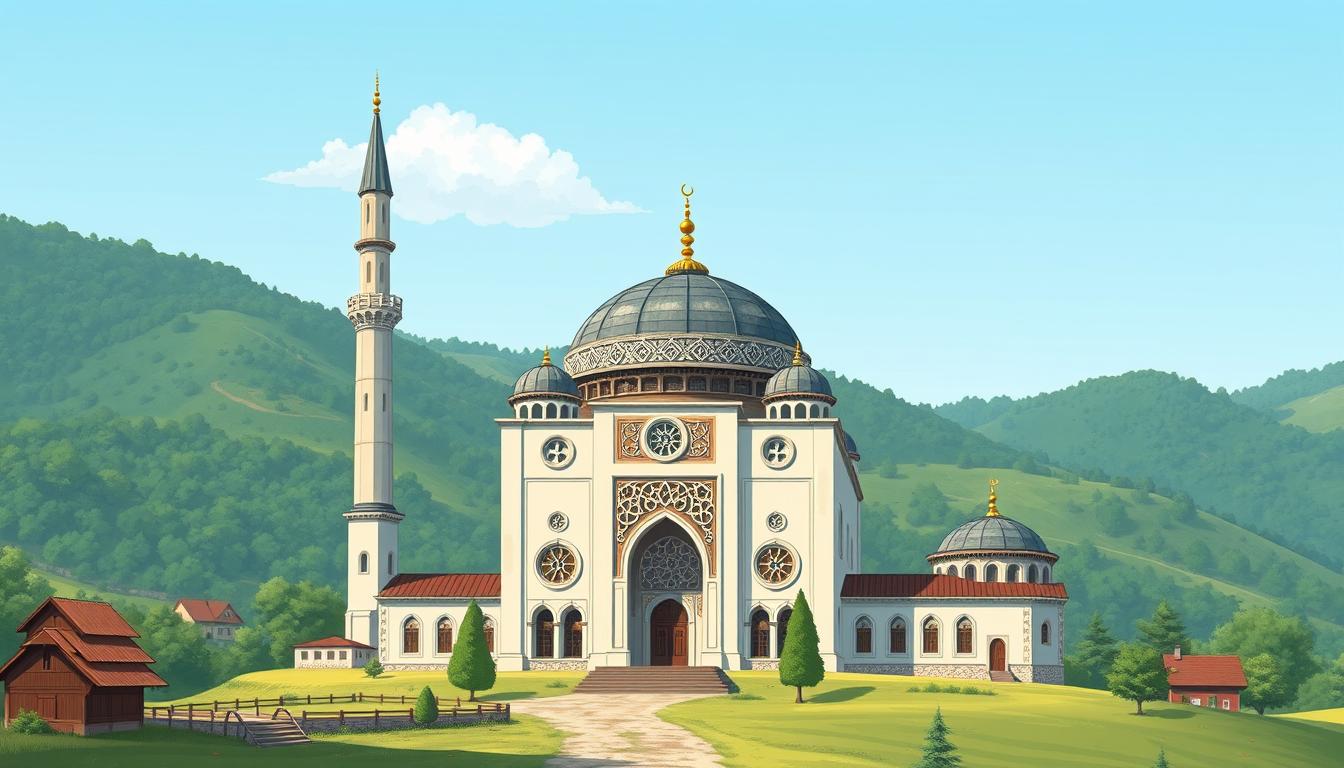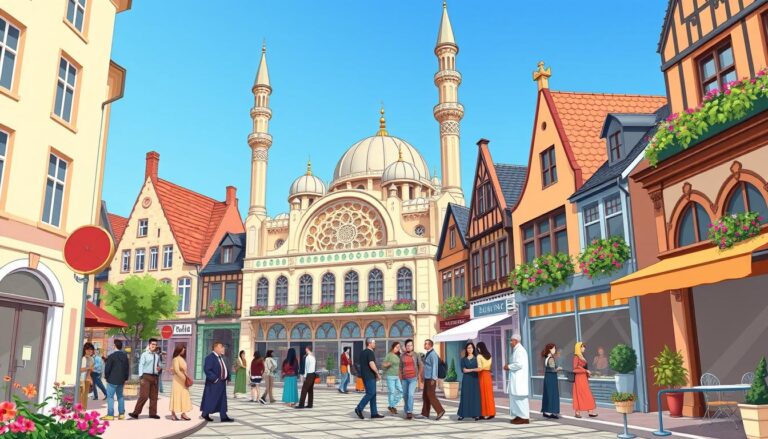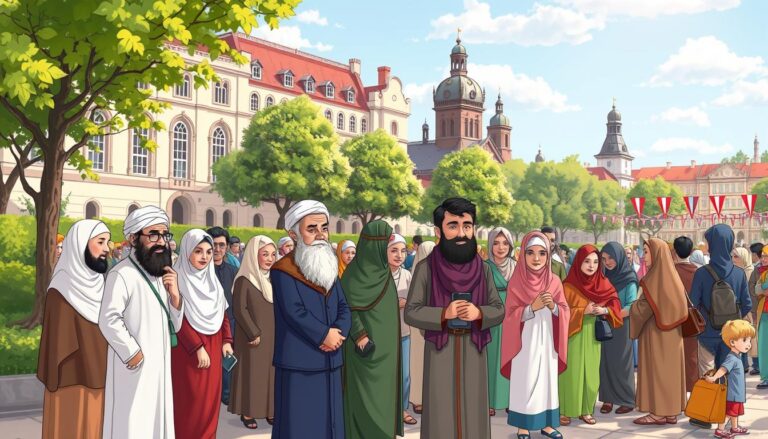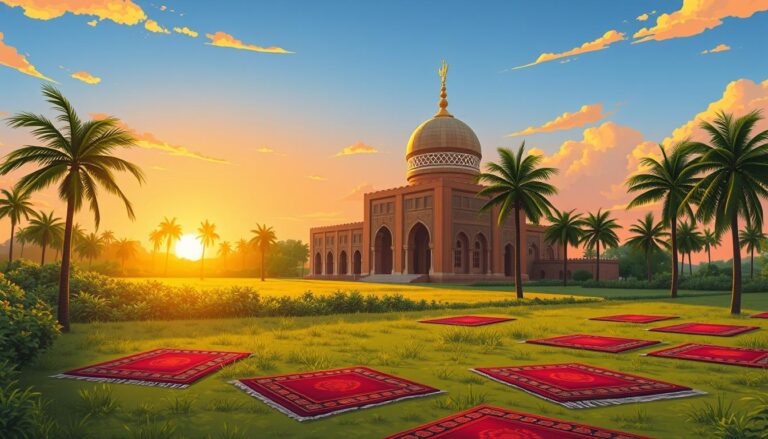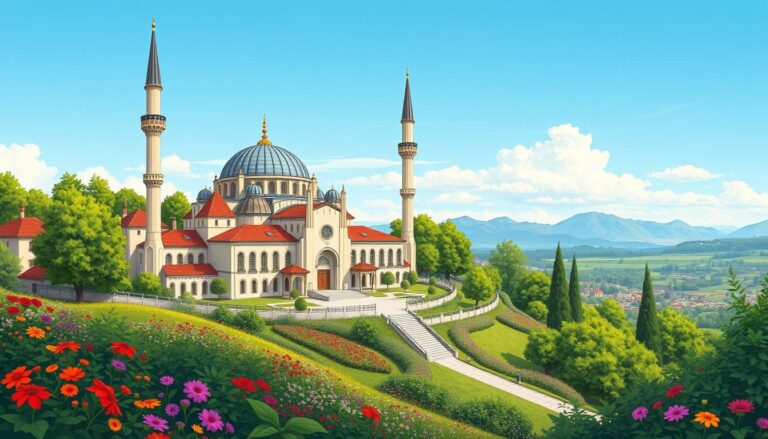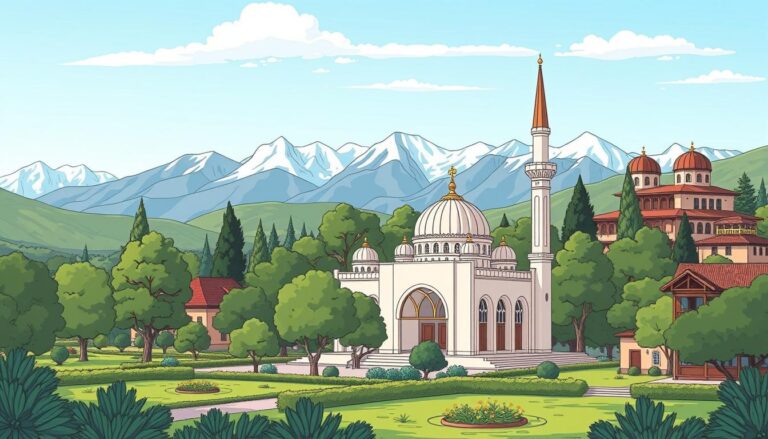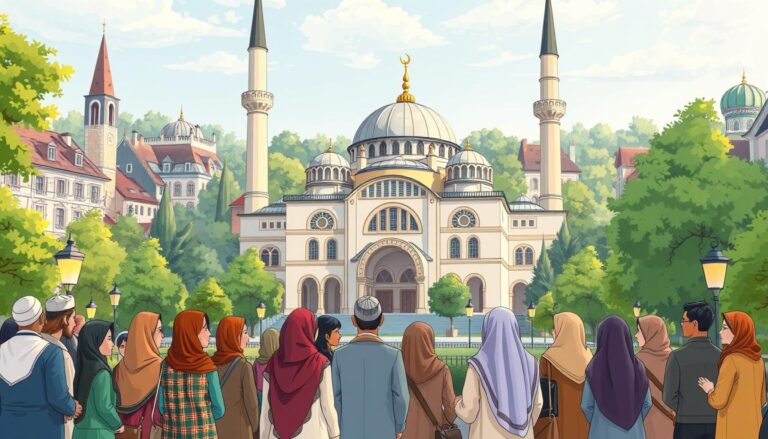Islam in Romania
According to the 2022 census, 76,215 people, approximately 0.4% of the total population, indicated that their religion was Islam, marking an increase from 2011, when 64,337 people declared adherence to Islam. The vast majority of Romania’s Muslims are Sunnis who adhere to the Hanafi school, with the largest ethnic groups being Tatars (Crimean Tatars and Nogais), Turks, and Muslim Roma. Islam has a 700-year tradition in Northern Dobruja, a region on the Black Sea coast that was part of the Ottoman Empire for almost five centuries.
Key Takeaways
- Islam is followed by only 0.4% of the population in Romania, with around 76,215 people identifying as Muslim.
- The majority of Romanian Muslims are Sunni Hanafis, with the largest ethnic groups being Tatars, Turks, and Muslim Roma.
- Islam has a long history in Northern Dobruja, a region that was part of the Ottoman Empire for nearly five centuries.
- Romania has around 80 mosques, with significant Muslim populations in urban centers like Bucharest, Brăila, and Constanța.
- The Muslim community in Romania is relatively well-integrated, with a focus on peaceful coexistence and religious tolerance.
Introduction to Islam in Romania
Islam has a long and significant history in Romania, particularly in the northern region of Dobruja. The presence of Islam in this area dates back to the Byzantine era when Sufi leader Sari Saltik established a local following. Over the centuries, the Islamic influence in Northern Dobruja expanded through successive waves of Ottoman rule and immigration.
Historical Significance of Islam in Northern Dobruja
Northern Dobruja, a region that has been part of Romania since the late 19th century, has witnessed a rich Islamic heritage. During the Ottoman era, the area saw a significant increase in the number of mosques and Muslim graveyards. However, the Muslim population in this region has been in steady decline since the late 1800s.
Demographics of Muslim Population in Romania
Today, the majority of adherents to Islam in Romania belong to the Tatar and Turkish ethnic communities, who primarily follow the Sunni doctrine. According to census data, the Muslim minority in Romania increased from 55,928 members (0.2%) in 1992 to 67,257 members (0.3%) in 2002, though it decreased slightly to 64,337 members (0.3%) in 2011. Muslims in Romania are organized within four religious associations, and the country has approximately 80 functional mosques.
“On 28 July 2015, an agreement was signed between the Romanian Government, the State Secretariat for Religious Affairs, and representatives of Muslim Worship for the free disposal of a land measuring 11,295 m2 for the construction of a mosque, library, and school for teaching the Koran.”
The presence of Islam in Northern Dobruja, the history of Islam in Romania, and the Muslim population demographics in Romania all contribute to the rich cultural tapestry of the country.
Early Islamic Presence in Romania
The early Islamic presence in Romania dates back to the arrival of the Pechenegs and Cumans, two Turkic nomadic groups, in the region. Around 1061 AD, when the Pechenegs ruled in Wallachia and Moldavia, there was a significant Muslim minority among them. Similarly, the Cumans, who arrived in the region around 1260 AD, also had a notable Muslim population.
Pechenegs and Cumans: The First Muslim Groups
The Pechenegs and Cumans were the first major Muslim groups to settle in what is now Romania. They brought their Islamic faith and culture with them, establishing a lasting influence in the region. The presence of these Turkic Muslim communities laid the groundwork for the later expansion of Islam in Romania.
Arrival of Seljuq Turks and Sari Saltik
In the 13th century, two prominent figures of the Seljuq Turks, the deposed Sultan Kaykaus II and the mystic Sari Saltik, were allowed to settle in the region during the reign of Michael VIII Palaiologos, the ruler of the Byzantine Empire. Researchers believe that Saltuk and his followers were in fact crypto-Shiite Alevis who sought refuge from persecution. The arrival of these Seljuq Turks and the influential figure of Sari Saltik further contributed to the early Islamic presence in Romania.
“The first significant numbers of Muslims arrived in Romania with the Pechenegs and Cumans, laying the groundwork for the later expansion of Islam in the region.”
Establishment of Ottoman Rule and Muslim Communities
The Ottoman Empire’s expansion into Romania began in the late 15th century, ushering in several centuries of Turkish rule. As the Ottomans gained control, they brought settlers from across their vast empire, establishing Muslim communities throughout the region. This period saw the Northern Dobruja area, which had previously been part of the Ottoman territories, come under Romanian sovereignty in 1878 after the young kingdom’s triumph over the weakening Ottoman Empire with assistance from Russia.
While some of the region’s Muslim population opted to leave for Turkey, others chose to remain. Their descendants now form the backbone of Romania’s contemporary Muslim community, preserving their cultural and religious identity within the country’s diverse social fabric.
“The Ottoman Empire’s conquest of Constantinople in 1453 marked a pivotal moment in the region’s history, paving the way for the establishment of Muslim enclaves across Romania.”
The influx of Ottoman settlers and the subsequent integration of Muslim communities into the social and economic fabric of the region had a profound and lasting impact. This legacy continues to shape the cultural landscape of Romania, where the Ottoman rule in Romania and Muslim communities in Romania have left an indelible mark.
Islam in Romania after 1878
Following the Russo-Turkish War of 1877–1878, Northern Dobruja became part of Romania. However, the Muslim community in the region managed to preserve its self-determining status. This changed during the communist regime, when Romanian Muslims were subject to a measure of supervision by the state. After the Romanian Revolution of 1989, the Muslim community emancipated itself and its interests are now represented by the Muftiyat (Muftiyatul Cultului Musulman din România), which was created as the reunion of two separate such institutions.
Northern Dobruja’s Integration into Romania
The integration of Northern Dobruja into Romania was a complex process. The region had a specific administrative regime until 1913, which limited political participation and property ownership for its residents. The Immovable Property Law of Dobruja in April 1882 aimed to transform Ottoman conditional ownership of agricultural land into capitalist property, leading to the redistribution of 82,127 hectares to Romanian colonists between 1889 and 1914. This had a significant impact on the ethnic makeup of the province.
Preservation of Muslim Identity and Rights
Despite the changes in the region, the Muslim community in Northern Dobruja managed to preserve its identity and rights. After the 1878 Treaty of Berlin, Muslims within the borders of new states were guaranteed rights of residence, ownership, and religious freedom, challenging the notion of equal citizenship, especially in Romania. This allowed the Muslim community to maintain its self-determining status, even during the communist regime, when they were subject to state supervision.
“The Muslim community in Romania is divided into 50 local groups, each electing its leadership committee. As of 2008, the Ministry of Culture and Religious Affairs recognizes 35 imams in Romania.”
Today, the Muslim community in Romania is represented by the Muftiyat, which was created as the reunion of two separate institutions. This organization ensures the preservation of Muslim identity and rights in the country.
Organizational Structure of Romanian Muslims
The Muslim community in Romania has a well-defined organizational structure that reflects its diverse makeup and rich heritage. At the heart of this structure lies the Muftiyat, the central religious authority that oversees the nation’s Muslim affairs.
Romania’s Muslim population is divided into around 50 local Muslim communities, each with its own elected leadership committee. These local groups are responsible for providing funding for their respective religious institutions, which is further supplemented by state donations, subsidies, and assistance from international Islamic organizations.
The Muslim clergy in Romania includes imams, imam-hatips, and muezzins, with the Constanța Mufti serving as the community’s main representative. The Mufti is elected by a secret ballot from among the imams and aided by a synodal body called Sura Islam, comprising 23 members.
This structured approach ensures that the diverse needs and interests of Romania’s Muslim communities are effectively addressed, fostering a sense of unity and collective identity within the broader Muslim organizational structure in Romania.
Islamic Architecture and Cultural Heritage
Romania’s Islamic cultural heritage is a testament to the country’s diverse history and the enduring presence of the Muslim community. With a rich architectural legacy, Romania boasts a remarkable collection of mosques and Islamic monuments that have stood the test of time.
Mosques and Islamic Monuments in Romania
Romania is home to as many as eighty mosques, with the Grand Mosque of Constanța and the Esmahan Sultan Mosque in Mangalia being the two most prominent. These stunning structures showcase the intricate craftsmanship and attention to detail that characterize Islamic architecture.
Beyond the mosques, Romania also houses several other state-recognized historical Islamic monuments. These include sites in Hârșova, Amzacea, Babadag, and Tulcea, as well as the Babadag tombs of two revered Sufi sheikhs. Additionally, the country is dotted with 108 Islamic cemeteries, further highlighting the enduring Islamic presence in Romania.
“The blend of culture, religion, and heritage preservation is emphasized in the overall discourse on Islamic architecture and cultural heritage across the sources.”
The preservation of these Islamic architectural gems is a testament to Romania’s commitment to safeguarding its diverse cultural heritage. As a crucial part of the country’s history and identity, these mosques and monuments serve as a powerful reminder of the rich tapestry of Islamic culture that has shaped the nation.
Islam in Romania
Romania’s Muslim population has experienced a gradual increase in recent years. According to the 2022 census, 76,215 people, approximately 0.4% of the total population, identified as Muslims. This marks a rise from the 2011 census, when 64,337 people declared adherence to Islam.
The majority of Romania’s Muslims are Sunnis who follow the Hanafi school of thought. The largest ethnic groups among the Muslim community are Tatars (Crimean Tatars and Nogais), Turks, and Muslim Roma. These communities have long-standing historical ties to the region and have played a significant role in shaping the country’s religious and cultural landscape.
“Islam in Romania is one of the eighteen officially recognized religious denominations in the country.”
The Muftiyat, the traditional representative of the Turkish-Tatar community, serves as the primary organizational structure for Muslims in Romania. This institution plays a crucial role in preserving the identity and rights of the Muslim population.
While the Muslim community in Romania is relatively small, it has maintained a distinct cultural and religious heritage. Recent studies have focused on the Turkish-Tatar community in the Eastern Dobruja region, highlighting their unique traditions and the Muftiyat’s role in representing their interests.
Romania’s religious freedom environment allows Muslims to practice their faith openly, although there have been some instances of resistance to initiatives, such as the construction of a Turkey-funded mega-mosque in Bucharest. The country’s multiculturalism is also reflected in organizations like the Centrul Cultural European Româno-Panarab (CCERPA), which promotes cultural exchange and understanding.
Despite the generally harmonious coexistence, reports on Islamophobia in Romania indicate the presence of some negative sentiments towards the Muslim population. The Romanian State Secretariat for Cults has engaged with representatives from the Turkish Ministry of Foreign Affairs and the Mufti to address these concerns and foster greater religious tolerance.
Muslim Ethnic Groups in Romania
Romania’s Muslim population is ethnically diverse, comprising various groups with distinct cultural and linguistic backgrounds. The largest Muslim ethnic communities in the country are the Tatars and Turks, followed by Muslim Roma and smaller numbers of Albanians and Middle Eastern immigrants.
Tatars and Turks
The Tatars, including both Crimean Tatars and Nogais, constitute the largest Muslim ethnic group in Romania, accounting for over 20,000 individuals. The Turks, who share linguistic and cultural ties with the Tatars, form the second-largest Muslim community, numbering around 26,900 people. The Tatars and Turks mostly reside in the northern Dobruja region, where they make up over 90% of the local Muslim population.
Muslim Roma
The Muslim Roma, also known as “Turkish Romani,” are another significant Muslim ethnic group in Romania. Estimates suggest there may be as many as 15,000 Muslim Roma in the country, though they are generally less religious compared to other Islamic communities. The Muslim Roma are believed to have converted to Islam during the Ottoman rule in the region.
Overall, the Muslim ethnic groups in Romania, including the Tatars, Turks, and Muslim Roma, make up a small but culturally diverse segment of the country’s population, contributing to the rich tapestry of Romania’s religious and cultural landscape.
Islamic Education and Practices in Romania
In Romania, the Muslim clergy includes imams, imam-hatips, and muezzins, with the Constanța Mufti serving as the community’s main representative. During the communist regime, Islamic education and practices faced challenges, as prayer was discouraged, and many mosques were sparsely attended, especially by young people.
However, since the fall of communism, Muslims in Romania have been able to freely practice their faith, and the number of active worshippers has increased. This resurgence in Islamic education and practices has led to the establishment of various initiatives, such as the “Let’s study Islam” course from the Center for Islamic Studies, which was first launched in 2009.
The “Let’s study Islam” course is aimed at Romanian speakers worldwide, focusing particularly on individuals from Romania and the Republic of Moldova. Each year, the course accommodates 30 students for a comprehensive study of Islam, with a duration of 8 months, divided into two semesters. The course covers a total of 16 subjects, and at the end of each semester, an online examination is conducted.
The teachers of the course are Romanian citizens who have graduated from Muslim theology faculties in various countries, such as Jordan, Turkey, and France. The exams for the course are held online, with a grading system where 70% is awarded for the online assessment and 30% for participation in courses or referrals.
The resurgence of Islamic education and practices in Romania is a reflection of the country’s religious diversity. According to the 2021 government census, while the majority of the population adheres to the Romanian Orthodox Church (73.6%), there are also significant numbers of Roman Catholics (3.9%), Greek Catholics, and other religious groups, including Muslims, who make up around 36,700 of the country’s population.
“The restoration of religious freedom after the fall of communism has allowed the Muslim community in Romania to revive its educational and cultural activities, contributing to the preservation of Islamic identity and practices in the country.”
Challenges and Integration of Muslims in Romanian Society
Compared to other countries in Eastern Europe, the experience of Muslims in Romania has largely been one of peaceful coexistence. While there were some protests over plans to construct a large Turkish-funded mosque in Bucharest in 2015, the presence of Muslims in Romania remains a marginal issue on the political and public agenda. The Muslims in Dobruja are well integrated, with Romanians accustomed to their presence and vice versa. There is little Islamophobic rhetoric witnessed in Romania, unlike in neighboring countries such as Hungary and Poland.
Peaceful Coexistence and Religious Tolerance
The adaptation of Muslim elites in Dobruca to Romanian policies between 1878 and 1914 involved invoking loyalty for the state and monarchy for integration, showcasing a strategic approach to navigating societal dynamics. The study highlights that “local Islamic revival has an ethno-cultural dimension (Tatar-Turks community), a religious and even a political one,” in the Romanian Muslim communities, showcasing the multifaceted nature of Muslim identity in Romania.
However, the research paper discusses the challenges faced by Romanian Muslims in integrating into society, including problems such as internal fragmentation, ideological and sectarian rivalry, and the lack of visible Islamic alternative discourses. The impact of transnational actors in influencing religious practices in the Dobruja region post-1990 is also highlighted, shedding light on external influences on Muslim communities in specific regions of Romania.
- Peaceful coexistence between Muslims and non-Muslims in Romania
- Marginal presence of Muslims in the political and public agenda
- Well-integrated Muslim community in the Dobruja region
- Lack of Islamophobic rhetoric compared to neighboring countries
- Challenges in integrating Muslims into Romanian society, including internal fragmentation and external influences
“The study highlights that ‘local Islamic revival has an ethno-cultural dimension (Tatar-Turks community), a religious and even a political one,’ in the Romanian Muslim communities, showcasing the multifaceted nature of Muslim identity in Romania.”
Conclusion
Islam has a long and vibrant history in Romania, especially in the Northern Dobruja region, where the religion has been established for over 700 years. While the Muslim population comprises only around 0.4% of the total population, the community has largely been able to preserve its identity and rights, even during periods of communist rule.
Today, Romania’s Muslims enjoy a relatively high level of integration and religious tolerance compared to other parts of Eastern Europe. The diverse ethnic and religious makeup of the country is embraced by the majority of the population, creating an environment of peaceful coexistence and mutual respect. This is a testament to the resilience and adaptability of the Muslim community in Romania, who have been able to maintain their traditions and practices while contributing to the overall cultural fabric of the nation.
As Romania continues to evolve, it is crucial that the rights and freedoms of all religious communities, including the Muslim minority, are protected and upheld. By fostering an inclusive and pluralistic society, Romania can serve as a model for the rest of the region, showcasing the benefits of embracing diversity and promoting interfaith dialogue. The future of Islam in Romania remains promising, with the potential for further growth and integration within the country’s vibrant social and cultural landscape.
Source Links
- Islam in Romania
- ‘People know and like their Muslim neighbours’
- L’islam – eurel
- ISIM-Newsletter-03
- Islam in Romania
- Religion in Romania
- Project MUSE – A Brief History of Islam in Europe
- Start reading The Afterlife of Ottoman Europe | Leyla Amzi-Erdogdular
- BBC – Religions – Islam: Ottoman Empire (1301-1922)
- Remembering and being. The memories of communist life in a Turkish …
- Islamic art: characteristics, works, architecture and mosaics
- Cultural Heritage Protection in Islamic Tradition | International Journal of Cultural Property | Cambridge Core
- ISIM-Newsletter-08
- Evolution of Political Islam in Romania at the Beginning of the Twenty-First Century
- Islam in Romania
- ONLINE EDUCATIONAL PROJECT “Let’s study Islam in Romanian languages” – Asociatia Musulmanilor din Romania
- 2023 Report on International Religious Freedom: Romania
- Muslims in Romania
- Multiculturalism and Islam in Romania. The Relations Between the Muslim Minorities and the Romanian State and Society
- Romania – United States Department of State
- Muslim Brotherhood activities in Romania – MENA Research Center

